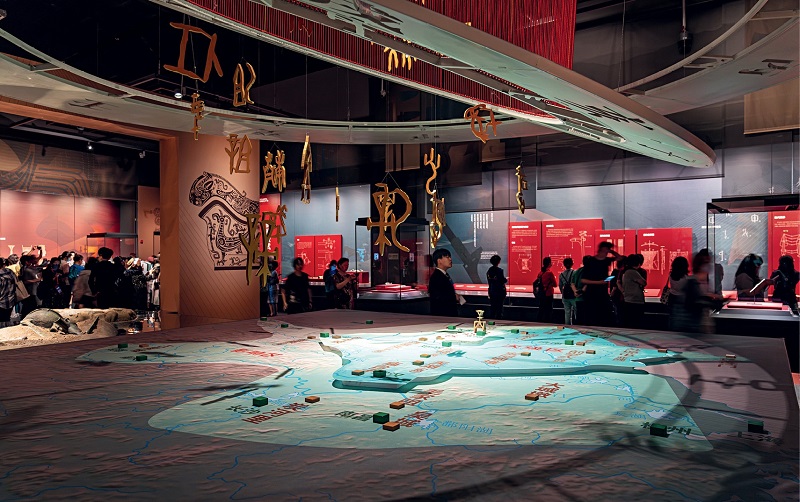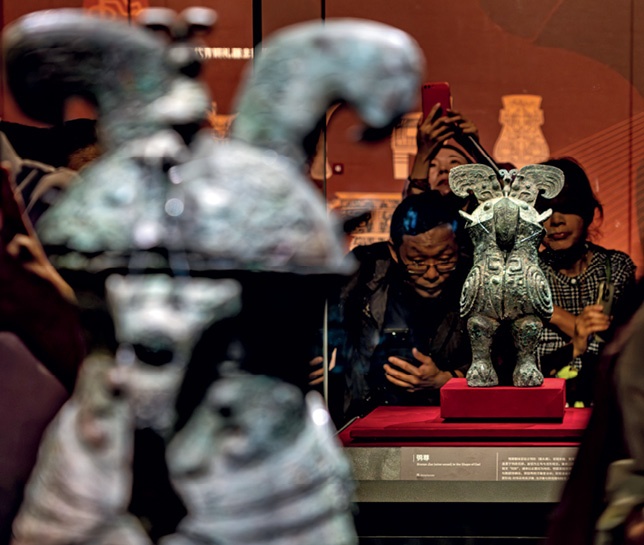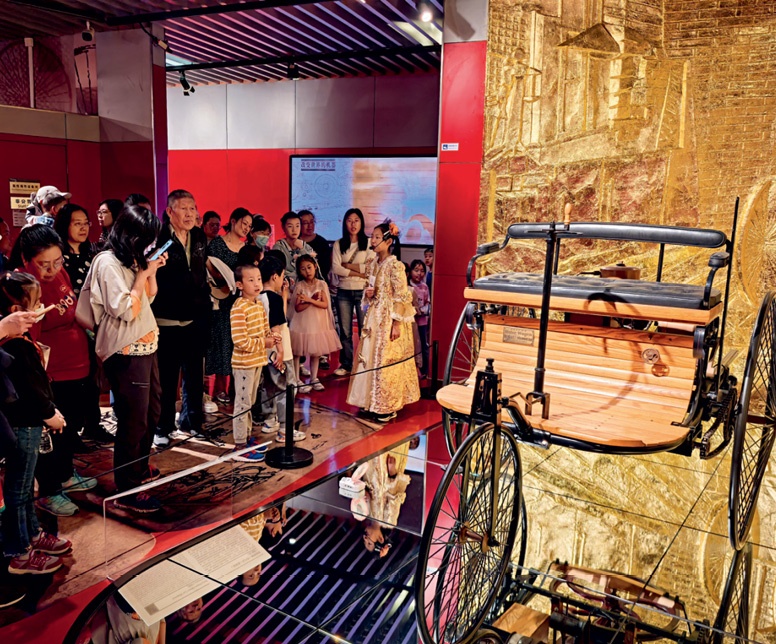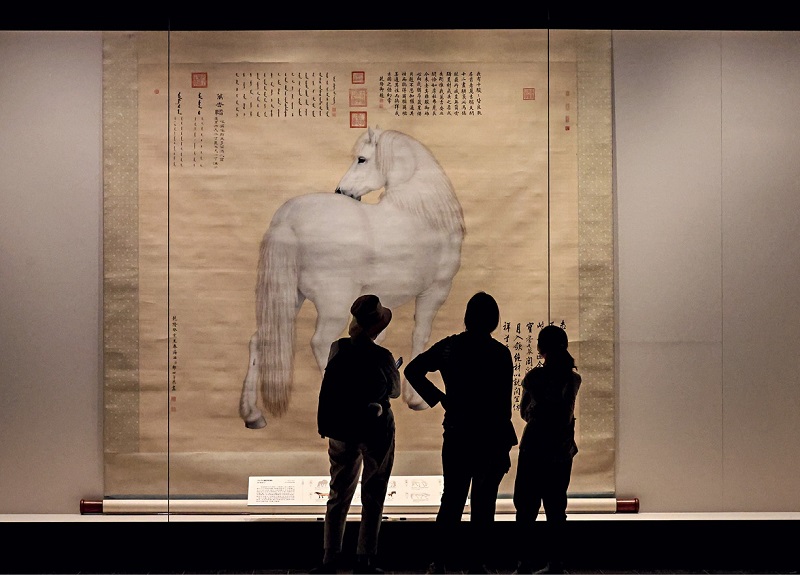
“The Exhibition Series on the Origins of Chinese Civilization: This is the Shang” is on display at the Grand Canal Museum of Beijing from May to October, exhibiting 338 pieces (sets) of precious cultural relics from 28 archaeological and cultural institutions across the country.
.jpg) “The Exhibition Series on the Origins of Chinese Civilization: This is the Shang” was unveiled at the Grand Canal Museum of Beijing on May 18, 2025 to celebrate the 2025 International Museum Day. It exhibits 338 pieces (sets) of precious cultural relics from 28 archaeological and cultural institutions across the country, narrating stories that date back over 3,500 years. The immersive experience provided by the museum helps visitors understand the legends behind those cultural relics and enjoy the blend of ancient traditions and modernity.
“The Exhibition Series on the Origins of Chinese Civilization: This is the Shang” was unveiled at the Grand Canal Museum of Beijing on May 18, 2025 to celebrate the 2025 International Museum Day. It exhibits 338 pieces (sets) of precious cultural relics from 28 archaeological and cultural institutions across the country, narrating stories that date back over 3,500 years. The immersive experience provided by the museum helps visitors understand the legends behind those cultural relics and enjoy the blend of ancient traditions and modernity.
Visitors at the exhibition take photos of a pair of owl-shaped bronze vessels that were unearthed from Fu Hao’s tomb with the inscription of her name on May 20, 2025.
.jpg) Unraveling the Mysteries of Chinese Civilization
Unraveling the Mysteries of Chinese CivilizationThe Shang Dynasty (c. 1600-1046 B.C.), was the first dynasty in China with explicit written records, which held an important and unique position in the long course of human history. As a carrier for exploring the origins of the Chinese civilization, archaeological discoveries in the remains of Shang’s capital city Yin are the key to decoding the early social structure and cultural evolution of China.
In the crowded exhibition hall, visitors wearing VR headsets can “touch” the dynamic oracle bone inscriptions and be transformed into Shang warriors who defended their city walls. Lady Fu Hao, wife of King Wu Ding of the Shang Dynasty, speaks to visitors about her legendary life as a queen and a female general with the help of AI technologies.
The ox-shaped bronze vessel unearthed at Shang general Ya Zhang’s tomb is a top tier cultural relic on display. Its body is intricately adorned with patterns of at least 26 animals, representing the exquisite bronze craftsmanship of that time period. A pair of owl-shaped vessels with inscriptions of Fu Hao unearthed from the lady’s tomb reunite in this exhibition since they are normally housed respectively in the National Museum of China and the Henan Museum.
“These bronze cultural relics and the historical site where they were found are evidence that the late Shang Dynasty was the first peak period of bronze ware production in ancient China,” a museum docent said. He noted that this pair of owl-shaped vessel artifacts are the key to decoding the religious rituals, military affairs, and gender roles in the Shang Dynasty.
The museum presents the continuity of this oriental civilization to visitors in a holistic way, guiding them forward by a red ribbon running through the exhibition hall to see some important cross-sections of Chinese civilization. After thousands of years of cultural collisions and integration, the Chinese nation has gradually formed into a community, demonstrating the continuous inheritance of Chinese civilization.

The Beijing Auto Museum sees a surge in visitors on the International Museum Day, which falls on May 18, 2025.
Cultural Vibrancy in an Ancient City
“Beijing is a city of museums. At present, nearly 300 registered museums and quasi-museums are located there. In 2024, Beijing held more than 2,000 exhibitions and over 30,000 relevant activities, receiving around 100 million visitors,” said Song Haojie, deputy director of Beijing Municipal Cultural Heritage Administration at a press briefing on May 15, 2025.
He announced that the 2025 Beijing Museum Season will extend from May to October, with each month being assigned a theme spanning from exhibitions to technologies, cultural and creative products, study tours, and social education. The season activities attempt to transform urban spaces into museum exhibition halls, presenting cultural charms with its creative works and displays, and meeting people’s growing needs for modern museums.
He gave some details of the monthly theme arrangement. In May, there were 100 select exhibitions; in June, a variety of digital exhibitions and technology-enabled activities have been organized in museums; in July, visitors will be served with cultural and creative products, fairs, and competitions, aiming to “bring the creativity of museums into people’s life” and also boost consumption in the capital city.
For August, there will be some designed study tours for museum lovers and primary and secondary school students. For example, a study tour on the theme of the Grand Canal has been prepared in Beijing’s Tongzhou District for children to learn historical knowledge while collecting the “pass” stamped on their museum “passport.”
In September, two online courses exploring the past and present of Beijing and the mysteries of Chinese characters will be launched targeting primary and secondary students. Meanwhile, first-year university students will be invited to museums to learn about the capital city.
The spokesperson said that Beijing had made a 12-year plan for building it into a “city of museums” (2024-2035), in which efforts will be made to promote the legislation on museums and deep integration of museums and the city.

Visitors are walking through a special exhibition of animal-themed paintings from the Palace Museum’s collection named “All Beings Thrive in Harmony” at the Main Palace Hall of Literary Brilliance on April 30, 2025.
Legacy and Innovation
On May 19, another eye-catching event titled “Endless Vitality: UN Stamp Launch and Palace Museum Exhibition” was held at the United Nations headquarters in New York, commemorating the 100th anniversary of the Palace Museum. It featured a special centennial stamp series issued by the UN Postal Administration to mark the museum’s 100th anniversary and International Museum Day.
The stamps feature 10 floral designs inspired by the museum’s vast collection of artifacts, which include patterns of plum blossoms, osmanthus, and peonies from cultural relics exhibited in the Palace Museum, covering categories such as paintings, furniture, ceramics, and architecture. The design integrates traditional aesthetics with modern craftsmanship, showcasing the beauty of a world cultural heritage site and conveying the vision that “All civilization flowers in full bloom make a beautiful garden.”
Wu Di, director of the Cultural and Creative Products Department of the Palace Museum, said that the Palace Museum has integrated the fine Chinese traditional culture into contemporary life through designing cultural and creative products. They connect history, the present, and the future, building a bridge for cross-temporal and cross-cultural dialogues.
Stamp, known as a nation’s “cultural card,” is not merely a piece of art portrayed on a small piece of paper but is also a proof of the times. Wu said the commemorative UN stamp sheet is dedicated to the 100-year-old Palace Museum (or the Forbidden City), which has endured 605 years of history, and to the 5,000-year-old Chinese civilization. “May the flowers of Chinese civilization be ever-lasting and bloom all over the world,” he said.
Atul Khare, UN under-secretary-general for operational support, highlighted the unique and powerful role of museums as “places where culture lives, where stories are told, and where people come together to learn and connect. They preserve our past, help us understand our present, and inspire our future.”
He praised the Palace Museum as “one of the world’s great cultural institutions,” and commended its work in giving Chinese heritage new meaning in today’s world. “Through its exhibitions, research, and international collaborations, the Palace Museum has brought Chinese civilization into conversation with the world,” he said.
According to the report released on the day of the 2025 International Museum Day in Beijing, by the end of 2024, China had had 7,046 registered museums, or one museum for every 200,000 people. Also in 2024, a total of 43,000 exhibitions and 511,000 educational events were held by Chinese museums nationwide, receiving 1.49 billion visitor arrivals.
From heavyweight exhibitions to immersive interaction, from technological empowerment to cultural and tourism experiences, Chinese museums are in sync with the times, showing new vitality in the rapidly changing communities and meeting people’s aspirations for a better life with high-quality cultural products and services.